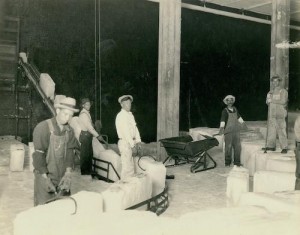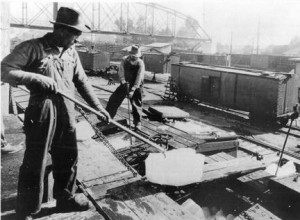The United Railway Icemen’s Union sought to organize the people who produced the ice for the refrigerated cars that took produce to market.
One of the few written records of this organization can be found in Mary Heaton Vorse’s Labor’s New Millions: The Growth of a People’s Power. The book was written in 1937 as the CIO was chartering a variety of new unions in the afterglow of the triumphant 1936 presidential election.

Workers at the PFE plant in Roseveille move ice blocks along a conveyer belt from the storage room to the railroad car. Photo courtesy of the Roseville Historical Society.
The largest ice producer in California was the Pacific Fruit Express (PFE), a joint operation of the Southern Pacific and Union Pacific railroads. It operated the world’s largest plant in Roseville, near Sacramento.
In 1936, the PFE provided ice to cool 339,336 carloads of perishable commodities.
Cutting 300-pound blocks of ice and moving them via a conveyer belt to the top of freight cars was a physically demanding job. Many of the workers were Mexican American. Latinos were among the key CIO leaders.
Fabian Garcia served as a United Railway Icemen’s Union committeeman at the PFE plant in Roseville, California. Salvador Martinez and Manuel Gardea served as union committeemen at the PFE plant in Bakersfield.
The CIO union sought strength through an affiliation with the United Cannery, Agricultural, Packing and Allied Workers of America (UCAPAWA).
Despite some initial organizing success, icehouse management in Roseville and Bakersfield signed contracts with the rival AFL Teamsters. It represented a lost opportunity to create a progressive voice for these Latino workers.
The United Railway Icemen’s Union quickly faded from the scene.
The production of ice continued for a number of decades until self-refrigerated cars replaced all of the older cars. The Roseville PFE plant stopped production in 1972 and was torn down in 1974.



PFE stood for Pacific Fruit EXPRESS, not Exchange.
The 300 bound blocks were manufactured that size, not cut from a larger block. The real work was breaking the blocks into chunks at the car before placing the chunks into the bunkers. This was a time sensitive operation.
The Rosevile plant was ideled after the 1972 season (not 1973) and was demolished in 1974 (correct). References:
Pacific Fruit Express
By Anthony W Thompson, Bruce H. Jones
Central Valley Railroad Publications (1992)
ISBN: 0963379127
Pacific Fruit Express
By Anthony W Thompson, Bruce H. Jones
Central Valley Railroad Publications (1992)
ISBN: 0963379127
Bob Chapara,
You are right and the PFE’s full name has been corrected. Thank you for catching the error.
Readers may also be interested in obtaining a copy of Roseville: Images of America, by the Roseville Historical Society and available through Arcadia Publishing.
The fist picture has my Grandfather Andres Luna he the one with cap lifting the block of Ice. My Grandmother ( Felipa Luna) also ran a boarding house for the railroad.